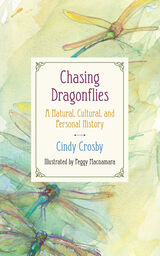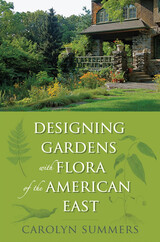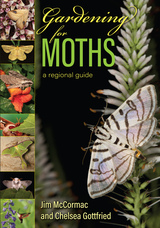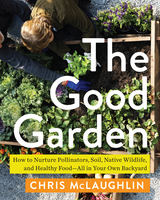
Chasing Dragonflies: A Natural, Cultural, and Personal History is an engaging, beautifully illustrated introduction to these remarkable insects. Drawing on her experiences as a natural history instructor, dragonfly monitor, cancer survivor, grandmother, and steward, Crosby tells the stories of dragonflies: their roles in poetry and art, their fascinating sex life—unique within the animal kingdom—and their evolution from dark-water dwellers to denizens of the air. We follow Crosby and other citizen-scientists into the prairies, wetlands, and woodlands of the Midwest, where they observe the environment and chronicle dragonfly populations and migration to decipher critical clues about our changing waterways and climate.
Woven throughout are personal stories: reflections on the author’s cancer diagnosis and recovery, change, loss, aging, family, joy, and discovering what it means to be at home in the natural world. Crosby draws an intimate portrait of a landscape teeming with variety and mystery, one that deserves our attention and conservation. As warm as it is informative, this book will interest gardeners, readers of literary nonfiction, and anyone intrigued by transformation, whether in nature or our personal lives.

Why indigenous plants, you may ask? What makes them so special to butterflies and bees and boys and girls? For Carolyn Summers, the answer is as natural as an ephemeral spring wildflower or berries of the gray dogwood, "As I studied indigenous plants, a strange thing happened. The plants grew on me. I began to love the plants themselves for their own unique qualities, quite apart from their usefulness in providing food and shelter for wildlife.
Emphasizing the importance of indigenous plant gardening and landscape design, Summers provides guidelines for skilled sowers and budding bloomers. She highlights . . .
- The best ways to use exotic and non-indigenous plants responsibly
- Easy-to-follow strategies for hosting wildlife in fields, forests, and gardens
- Designs for traditional gardens using native trees, shrubs, groundcovers as substitutes for exotic plants
- Examples of flourishing plant communities from freshwater streams to open meadows
- How to control plant reproduction, choose cultivars, open-pollinated indigenous plants, and different types of hybrids, and practice “safe sex in the garden

In this fully revised second edition of the classic guide Designing Gardens with Flora of the American East, gardening expert Carolyn Summers draws on the most recent research on sustainable landscaping. She is joined in this edition by her daughter, landscape designer Kate Brittenham, offering an intergenerational dialogue about the importance of using indigenous plants that preserve insect and bird habitats. The practical information they provide is equally useful for home gardeners and professionals, including detailed descriptions of keystone trees, shrubs, perennials, vines, and grasses that are native to the eastern United States. Accompanied by entirely new illustrations and updated plant lists, they offer chic yet eco-friendly landscape designs fully customized for different settings, from suburban yards to corporate office parks.
The states covered in this book are CT, DE, IA, IL, IN, KY, MA, MD, ME, MI, MN, MO, NC, NH, NJ, NY, OH, PA, RI, TN, VA, VT, WI, and WV, as well as southern Quebec and Ontario.

This guide to moths, native plants, and their environmental roles is an indispensable resource for gardeners, conservationists, and nature enthusiasts across the midwestern United States.
Gardening for Moths is the first book to show midwestern gardeners and naturalists why they should attract specific moth species to their properties and how to do it. The book’s stunning color photographs and intriguing facts reveal the fascinating world of these insects, inspiring readers to incorporate moth-loving native plants into their landscapes. The authors emphasize the importance of moths and their caterpillars to ecological food webs, widening the book’s appeal to birders and bat lovers as well.
The book consists of three main sections, beginning with a thorough overview of moths, including their
- population decline and conservation,
- importance in ecosystems,
- relationship with native plants, and
- predators and defenses
In the next section the authors profile about 140 plant species, providing brief background, natural history, habitat, and growing notes for each along with lists of potential moths the plants may attract.
The third section highlights approximately 150 moth species, ordered taxonomically. These accounts include interesting facts about the life history of both the caterpillar and adult moth of each species. Each account also features a list of the species’ common host plants.
Throughout the volume, inset text boxes provide additional fascinating moth facts. Beautiful photographs (most by the authors) illustrate every included plant and moth species. Select references, online resources, and quick reference tables round out this valuable resource.

McLaughlin gives you all the tricks and tips you need to grow the sustainable garden of your dreams. Drawing from established traditions, such as permaculture and French intensive gardening, and McLaughlin’s hard-earned experience, The Good Garden is a joyful guide for newbies and experienced gardeners alike. It will teach you the fundamentals, including how to choose the right plant varieties for your microclimate, and proven methods to fight pests without chemicals. You will also discover the nuances of developing a green thumb, from picking species to attract specific types of pollinators to composting techniques based on time available. Lovely four-color photography will show you good gardening in action.
Most importantly, The Good Garden will help you foster a sense of meaning in your garden. Maybe the goal is to reduce food miles and plastic waste by growing delicious berries. Maybe it’s to meet neighbors who also care about the planet through a seed-swap. Maybe it’s a quiet moment patting the bunny whose manure will replace toxic fertilizers in the soil. A good garden offers endless possibilities and The Good Garden offers a wealth of knowledge and inspiration.

If you’re a gardener (or aspiring gardener) in the Northeast, Upper Midwest, or Great Lakes region, this beautiful 4-color guide will become your go-to reference to the most beneficial plants in your area. It includes profiles of more than 300 native plants, featuring lovely illustrations and photos, information on blooming periods, exposure, soil moisture, and good plant companions, as well as how each species supports specific pollinators.
You’ll learn more about common plants you thought you knew and be introduced to species you may have never encountered before. Blooming flowers, native grasses, trees, shrubs, vines, and plants for rain and pond gardens are all included. White Baneberry, Woodland Strawberry, Boneset, Virginia Mountain Mint, Smooth Aster, and many others may find their way from these pages to your soil.
While understanding specific plants is key, so too are growing strategies. Here you’ll learn how to prepare your site and find sample garden designs, whether your growing space is an apartment balcony, a residential yard, or a community garden. Throughout, you’ll discover the power of plants to not only enrich your personal environment but to support the pollinators necessary for a thriving planet.
READERS
Browse our collection.
PUBLISHERS
See BiblioVault's publisher services.
STUDENT SERVICES
Files for college accessibility offices.
UChicago Accessibility Resources
home | accessibility | search | about | contact us
BiblioVault ® 2001 - 2024
The University of Chicago Press









